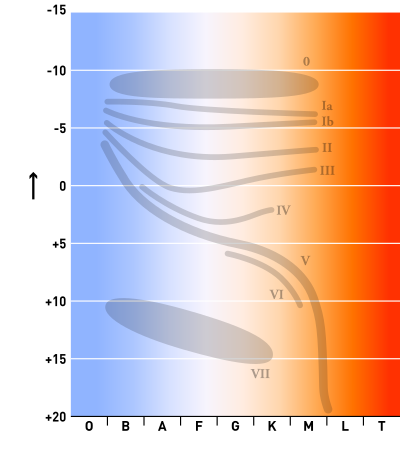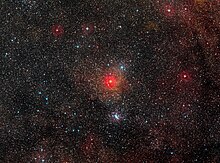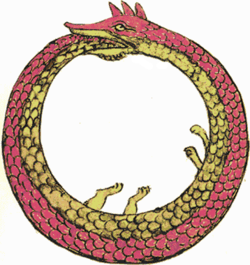Comparison of (left to right) the Pistol Star, Rho Cassiopeiae, Betelgeuse, and VY Canis Majoris superimposed on an outline of the Solar System. The blue half-ring centered near the left edge represents the orbit of Neptune, the outermost planet of the Solar System.
A hypergiant (luminosity class 0 or Ia+) is among the very rare kinds of stars that typically show tremendous luminosities and very high rates of mass loss by stellar winds. The term hypergiant is defined as luminosity class 0 (zero) in the MKK system.
However, this is rarely seen in the literature or in published spectral
classifications, except for specific well-defined groups such as the yellow hypergiants, RSG (red supergiants), or blue B(e) supergiants with emission spectra. More commonly, hypergiants are classed as Ia-0 or Ia+,
but red supergiants are rarely assigned these spectral classifications.
Astronomers are interested in these stars because they relate to
understanding stellar evolution, especially with star formation,
stability, and their expected demise as supernovae.
Origin and definition
In 1956, the astronomers Feast and Thackeray used the term super-supergiant (later changed into hypergiant) for stars with an absolute magnitude brighter than MV = −7 (MBol will be larger for very cool and very hot stars, for example at least −9.7 for a B0 hypergiant). In 1971, Keenan suggested that the term would be used only for supergiants showing at least one broad emission component in Hα,
indicating an extended stellar atmosphere or a relatively large mass
loss rate. The Keenan criterion is the one most commonly used by
scientists today.
To be classified as a hypergiant, a star must be highly luminous
and have spectral signatures showing atmospheric instability and high
mass loss. Hence it is possible for a non-hypergiant, supergiant star to
have the same or higher luminosity as a hypergiant of the same spectral
class. Hypergiants are expected to have a characteristic broadening and
red-shifting of their spectral lines, producing a distinctive spectral
shape known as a P Cygni profile.
The use of hydrogen emission lines is not helpful for defining the
coolest hypergiants, and these are largely classified by luminosity
since mass loss is almost inevitable for the class.
Formation
Stars with an initial mass above about 25 M☉
quickly move away from the main sequence and increase somewhat in
luminosity to become blue supergiants. They cool and enlarge at
approximately constant luminosity to become a red supergiant, then
contract and increase in temperature as the outer layers are blown away.
They may "bounce" backwards and forwards executing one or more "blue
loops", still at a fairly steady luminosity, until they explode as a supernova or completely shed their outer layers to become a Wolf–Rayet star. Stars with an initial mass above about 40 M☉
are simply too luminous to develop a stable extended atmosphere and so
they never cool sufficiently to become red supergiants. The most massive
stars, especially rapidly rotating stars with enhanced convection and
mixing, may skip these steps and move directly to the Wolf–Rayet stage.
This means that stars at the top of the Hertzsprung–Russell diagram
where hypergiants are found may be newly evolved from the main sequence
and still with high mass, or much more evolved post-red supergiant
stars that have lost a significant fraction of their initial mass, and
these objects cannot be distinguished simply on the basis of their
luminosity and temperature. High-mass stars with a high proportion of
remaining hydrogen are more stable, while older stars with lower masses
and a higher proportion of heavy elements have less stable atmospheres
due to increased radiation pressure and decreased gravitational
attraction. These are thought to be the hypergiants, near the Eddington limit and rapidly losing mass.
The yellow hypergiants are thought to be generally post-red
supergiant stars that have already lost most of their atmospheres and
hydrogen. A few more stable high mass yellow supergiants with
approximately the same luminosity are known and thought to be evolving
towards the red supergiant phase, but these are rare as this is expected
to be a rapid transition. Because yellow hypergiants are post-red
supergiant stars, there is a fairly hard upper limit to their luminosity
at around 500,000–750,000 L☉, but blue hypergiants can be much more luminous, sometimes several million L☉.
Almost all hypergiants exhibit variations in luminosity over time
due to instabilities within their interiors, but these are small except
for two distinct instability regions where luminous blue variables (LBVs) and yellow hypergiants
are found. Because of their high masses, the lifetime of a hypergiant
is very short in astronomical timescales: only a few million years
compared to around 10 billion years for stars like the Sun.
Hypergiants are only created in the largest and densest areas of star
formation and because of their short lives, only a small number are
known despite their extreme luminosity that allows them to be identified
even in neighbouring galaxies. The time spent in some phases such as
LBVs can be as short as a few thousand years.
Stability
Great nebula in Carina, surrounding Eta Carinae
As the luminosity of stars increases greatly with mass, the luminosity of hypergiants often lies very close to the Eddington limit,
which is the luminosity at which the radiation pressure expanding the
star outward equals the force of the star's gravity collapsing the star
inward. This means that the radiative flux passing through the photosphere
of a hypergiant may be nearly strong enough to lift off the
photosphere. Above the Eddington limit, the star would generate so much
radiation that parts of its outer layers would be thrown off in massive
outbursts; this would effectively restrict the star from shining at
higher luminosities for longer periods.
A good candidate for hosting a continuum-driven wind is Eta Carinae, one of the most massive stars ever observed. With an estimated mass of around 130 solar masses and a luminosity four million times that of the Sun, astrophysicists speculate that Eta Carinae may occasionally exceed the Eddington limit.
The last time might have been a series of outbursts observed in
1840–1860, reaching mass loss rates much higher than our current
understanding of what stellar winds would allow.
As opposed to line-driven stellar winds (that is, ones driven by absorbing light from the star in huge numbers of narrow spectral lines), continuum driving does not require the presence of "metallic" atoms — atoms other than hydrogen and helium, which have few such lines — in the photosphere.
This is important, since most massive stars also are very metal-poor,
which means that the effect must work independently of the metallicity. In the same line of reasoning, the continuum driving may also contribute to an upper mass limit even for the first generation of stars right after the Big Bang, which did not contain any metals at all.
Another theory to explain the massive outbursts of, for example, Eta Carinae
is the idea of a deeply situated hydrodynamic explosion, blasting off
parts of the star's outer layers. The idea is that the star, even at
luminosities below the Eddington limit, would have insufficient heat convection
in the inner layers, resulting in a density inversion potentially
leading to a massive explosion. The theory has, however, not been
explored very much, and it is uncertain whether this really can happen.
Another theory associated with hypergiant stars is the potential
to form a pseudo-photosphere, that is a spherical optically dense
surface that is actually formed by the stellar wind rather than being
the true surface of the star. Such a pseudo-photosphere would be
significantly cooler than the deeper surface below the outward-moving
dense wind. This has been hypothesized to account for the "missing"
intermediate-luminosity LBVs and the presence of yellow hypergiants at
approximately the same luminosity and cooler temperatures. The yellow
hypergiants are actually the LBVs having formed a pseudo-photosphere and
so apparently having a lower temperature.
Relationships with Ofpe, WNL, LBV, and other supergiant stars
Very Large Telescope image of the surroundings of VY Canis Majoris
Hypergiants are evolved, high luminosity, high-mass stars that occur in the same or similar regions of the HR diagram
to stars with different classifications. It is not always clear whether
the different classifications represent stars with different initial
conditions, stars at different stages of an evolutionary track, or is
just an artifact of our observations. Astrophysical models explaining
the phenomena
show many areas of agreement. Yet there are some distinctions that are
not necessarily helpful in establishing relationships between different
types of stars.
Although most supergiant stars are less luminous than hypergiants of similar temperature, a few fall within the same luminosity range.
Ordinary supergiants compared to hypergiants often lack the strong
hydrogen emissions whose broadened spectral lines indicate significant
mass loss. Evolved lower mass supergiants do not return from the red
supergiant phase, either exploding as supernovae or leaving behind a
white dwarf.
Luminous blue variables
are a class of highly luminous hot stars that display characteristic
spectral variation. They often lie in a "quiescent" zone with hotter
stars generally being more luminous, but periodically undergo large
surface eruptions and move to a narrow zone where stars of all
luminosities have approximately the same temperature, around 8,000K. This "active" zone is near the hot edge of the unstable "void" where yellow hypergiants
are found, with some overlap. It is not clear whether yellow
hypergiants ever manage to get past the instability void to become LBVs
or explode as a supernova.
Blue hypergiants are found in the same parts of the HR diagram as
LBVs but do not necessarily show the LBV variations. Some but not all
LBVs show the characteristics of hypergiant spectra at least some of the
time, but many authors would exclude all LBVs from the hypergiant class and treat them separately. Blue hypergiants that do not show LBV characteristics may be progenitors of LBVs, or vice versa, or both. Lower mass LBVs may be a transitional stage to or from cool hypergiants or are different type of object.
Wolf–Rayet stars
are extremely hot stars that have lost much or all of their outer
layers. WNL is a term used for late stage (i.e. cooler) Wolf–Rayet stars
with spectra dominated by nitrogen. Although these are generally
thought to be the stage reached by hypergiant stars after sufficient
mass loss, it is possible that a small group of hydrogen-rich WNL stars
are actually progenitors of blue hypergiants or LBVs. These are the
closely related Ofpe (O-type spectra plus H, He, and N emission lines,
and other peculiarities) and WN9 (the coolest nitrogen Wolf–Rayet stars)
which may be a brief intermediate stage between high mass main-sequence
stars and hypergiants or LBVs. Quiescent LBVs have been observed with
WNL spectra and apparent Ofpe/WNL stars have changed to show blue
hypergiant spectra. High rotation rates cause massive stars to shed
their atmospheres quickly and prevent the passage from main sequence to
supergiant, so these directly become Wolf–Rayet stars. Wolf Rayet
stars, slash stars, cool slash stars (aka WN10/11), Ofpe, Of+, and Of*
stars are not considered hypergiants. Although they are luminous and
often have strong emission lines, they have characteristic spectra of
their own.
Known hypergiants
Hypergiants
are difficult to study due to their rarity. Many hypergiants have
highly variable spectra, but they are grouped here into broad spectral
classes.
Luminous blue variables
Some luminous blue variables are classified as hypergiants, during at least part of their cycle of variation:
- Eta Carinae, inside the Carina Nebula (NGC 3372) in the southern constellation of Carina. Eta Carinae is extremely massive, possibly as much as 120 to 150 times the mass of the Sun, and is four to five million times as luminous. Possibly a different type of object from the LBVs, or extreme for a LBV.
- P Cygni, in the northern constellation of Cygnus. Prototype for the general characteristics of LBV spectral lines.
- S Doradus, in the Large Magellanic Cloud, in the southern constellation of Dorado. Prototype variable, LBVs are still sometimes called S Doradus variables.
- The Pistol Star (V4627 Sgr), near the center of the Milky Way, in the constellation of Sagittarius. The Pistol Star is possibly as much as 150 times more massive than the Sun, and is about 1.7 million times more luminous. Considered a candidate LBV, but variability has not been confirmed.
- V4029 Sagittarii
- V905 Scorpii
- HD 6884, (R40 in SMC)
- HD 269700, (R116 in the LMC)
- LBV 1806-20 in the 1806-20 cluster on the other side of the Milky Way.
Blue hypergiants
A hypergiant star and its proplyd proto-planetary disk compared to the size of the Solar System
Usually B-class, occasionally late O or early A: candidate with a supergiant companion:
- BP Crucis (Wray 977 or GX 301-2), binary with a pulsar companion.
- Cygnus OB2-12
- HD 32034 (R62 in LMC)
- HD 37974 (R126 in LMC)
- HD 80077, LBV candidate`
- HD 268835 (R66 in LMC)
- HD 269781 (in LMC)
- HD 269661 (R111 in LMC)
- HD 269604 (in LMC)
- HDE 269128 (R81 in LMC), LBV candidate, eclipsing binary system.
- HT Sagittae
- V430 Scuti
- V452 Scuti, LBV candidate
- V1429 Aquilae (= MWC 314), LBV
- V1768 Cygni
- V2140 Cygni
- V4030 Sagittarii
- Zeta¹ Scorpii
- Star 13, type O, LBV candidate
- Star 18, type O, LBV candidate
- W5 (possible Wolf–Rayet)
- W7
- W13 (binary?)
- W33
- W42a
Yellow hypergiants
Field surrounding the yellow hypergiant star HR 5171
Yellow hypergiants with late A -K spectra.
- HD 7583 (R45 in SMC)
- HD 33579 (in LMC)
- HD 268757 (R59 in LMC)
- IRAS 17163-3907
- IRAS 18357-0604
- IRC+10420 (V1302 Aql)
- Rho Cassiopeiae
- V382 Carinae
- V509 Cassiopeiae
- V766 Centauri (HR 5171A)
- V1427 Aquilae
- Variable A (in M33)
- W4
- W8a
- W12a
- W16a
- W32
- W265
Plus at least two probable cool hypergiants in the recently discovered Scutum Red Supergiant Clusters: F15 and possibly F13 in RSGC1 and Star 49 in RSGC2.
Red hypergiants
Size comparison between the diameter of the Sun and VY Canis Majoris, a hypergiant which is among the largest known stars
M type spectra, the largest known stars.
A survey expected to capture virtually all Magellanic Cloud red hypergiants detected around a dozen M class stars Mv−7
and brighter, around a quarter of a million times more luminous than
the Sun, and from about 1,000 times the radius of the Sun upwards.







